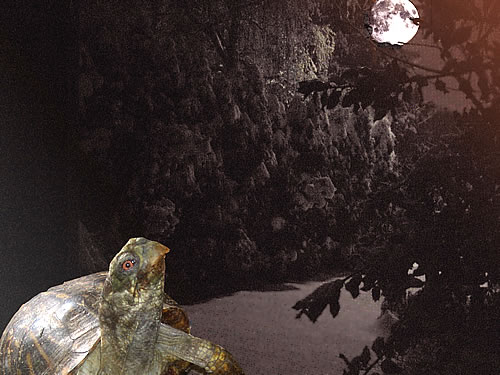The turtle in the illustration is a male ornate box turtle, father of five of the turtles in our bale of turtles in the Chelonian Connection lab. Yes, “bale” is the collective noun for a bunch of turtles, though it’s hard to imagine their being wrapped together like a bale of hay.
The poem associated with the picture, like most of my writing, has a turtle topic. (A note to anyone who writes prose, whether it’s about turtles or anything else: Writing poetry, with its concentration, imagery, sound relationships, and attention to rhythm, can improve your prose writing.)
Early in the year BluePrintReview, an established online literary journal coming out of Germany, put out a call for collaborative works including verbal and visual media: “Synergetic Transformations.” I was intrigued, for the poem "Haunted Garden" was already completed as a collaborative work with one of my students; the theme was a natural, and I sent it in, along with an illustration (above) and notes about the ancient form and the way we’d adapted it.
One of our Last Monday Poetry events, for which I’m a codirector, had been an introduction to the Japanese form renga (similar to renku) by Brad Wolthers. The workshop participants wrote a round of stanzas, recreating renga as the collaborative party game it has been for centuries, leading the next week to an e-mail renga with eighteen participants, then to our “Haunted Garden,” written in the trade-off process: three lines in the voice of a turtle, two lines in response.
Our collaboration was accepted. Dorothee Lang, BluePrintReview editor, soon learned that two pairs of collaborators accepted for the issue lived in the Portland, Oregon, metro area and that poet John Sibley Williams, who recently presented at Last Monday Poetry, was already a friend; she suggested entries on our blogs. If, before our work was accepted, we’d discussed BluePrintReview, we wouldn't have been so surprised when we discovered we four were about to be published in the same journal, the same issue, in far-off Germany. The explanation? Our ideas to submit came from the same source: a mutual friend, practitioner of poetry and multiple arts Anatoly Molotkov, who kindly posted the journal information on Facebook.
The “Haunted Garden” collaboration is online now at www.blueprintreview.de, a happy resident in a beautiful issue. Here is the poem’s ending, suitable for a blue-sky day in an Oregon spring, bright with cherry blossoms and, yes, the masses of white bell-like blooms sprawling out in the sun from our Pieri japonica, outside the turtles’ garden window.Season of fear leaves.
Silent shoots sign early spring,
garden smiles again.
Violas, pieri survive.
Turtle smiles, taps his poem.
Thanks to A. Molotkov for sharing the journal information; Brad Wolthers, whose renga, haiku, and other poems in the Japanese tradition are published in several books; and to Margaret Chula, much-honored Portland poet and specialist in Japanese poetry, who influenced my notes by identifying the ways in which our hybrid style differed from the strict practice of renga and renku.

